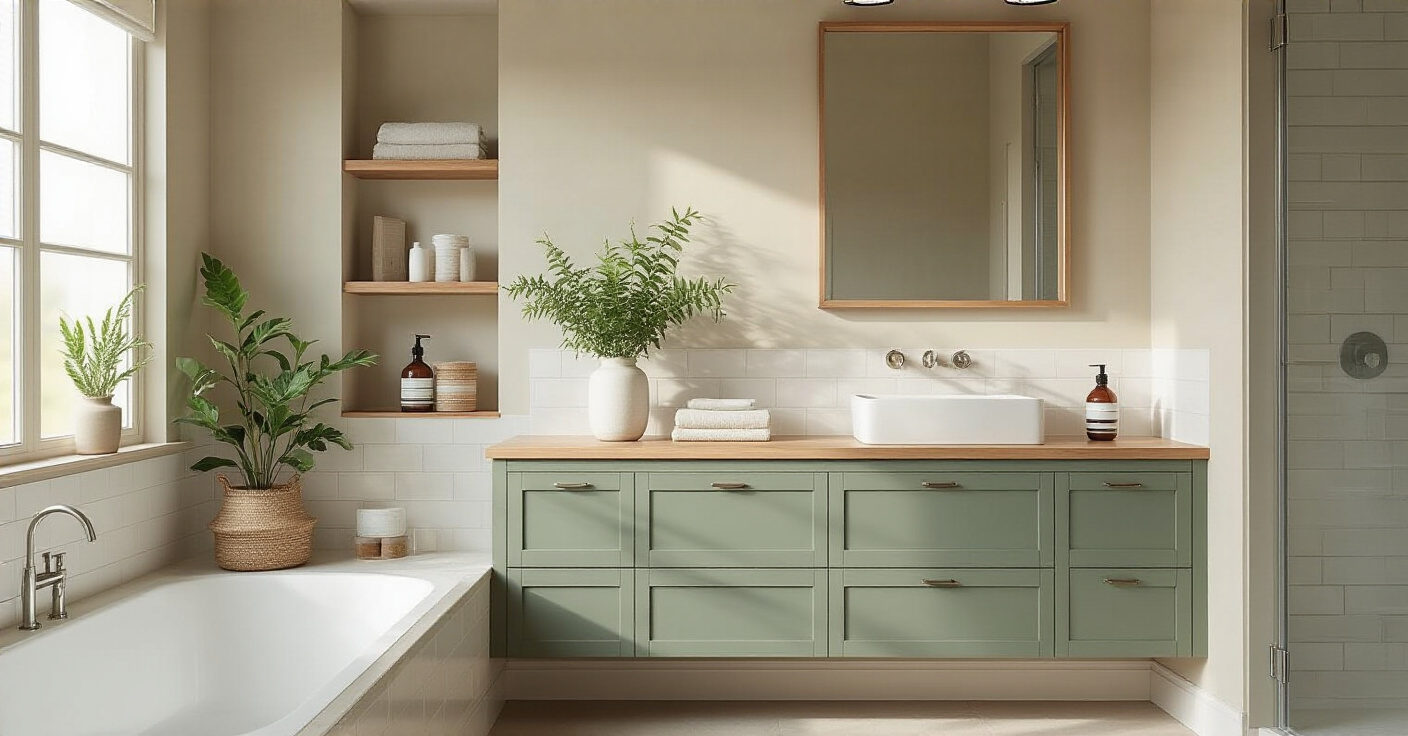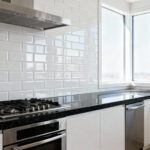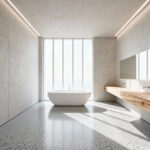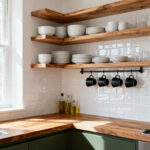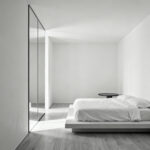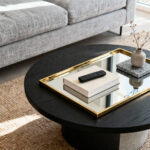Can we just talk about why almost everyone gets bathroom decor wrong? They treat it like an afterthought. Like it’s a living room, but with more tile and a toilet to work around. They grab some nice-looking towels, a fancy soap dispenser, and call it a day. But a bathroom isn’t just another room. It’s a high-performance, high-humidity, small-footprint machine for living. Decorating it requires precision—the kind I learned shooting architecture, where one bad shadow or out-of-place fixture could ruin a million-dollar shot.
So, let’s cut the corporate-speak and the fluffy blog posts. You’re smart, you’re busy, and you want to know what actually works. I’m going to break down how to approach this methodically, from the foundational decisions that make or break a space to the specific elements that add real value and style. This is the stuff I wish someone had told me 15 years ago.
Laying the Stylish Foundation: Initial Planning & Essentials
Before you even think about a new shower curtain or a fancy candle, we have to talk about the 骨架. Get these first five things right, and the rest is easy. Get them wrong, and you’ll just be putting expensive lipstick on a pig.
1. Define Your Cohesive Color Palette for Harmony
The biggest mistake I see is people picking colors piecemeal. They find a vanity they love, then tiles they love, then paint they love, and suddenly they’re standing in a room where nothing actually works together. The problem is usually undertones—that cool gray vanity is fighting the warm beige tile, and it creates this low-grade visual tension that just feels off. Your color palette is your single most important decision. It’s the unifying logic for the entire room.
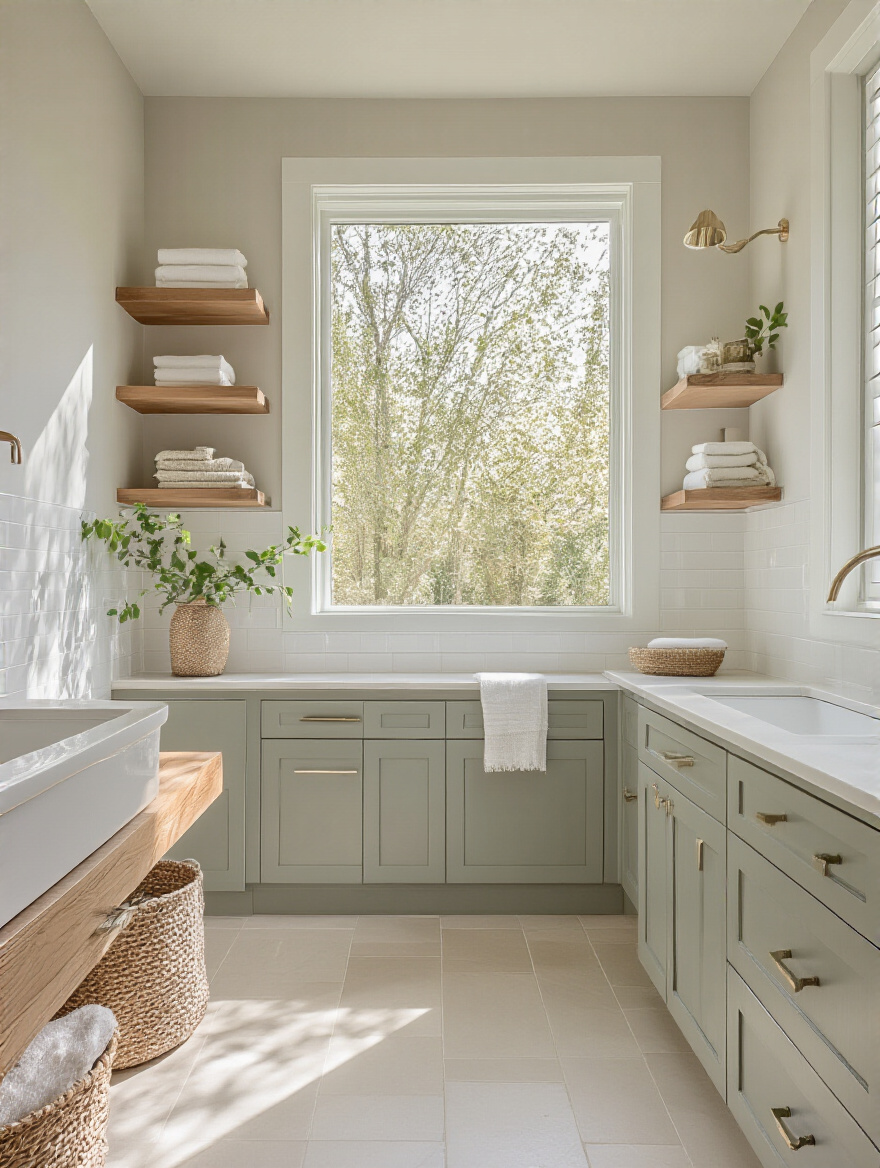
Here’s the shortcut: Use the 60-30-10 rule. 60% of your room is your dominant color (walls). 30% is your secondary color (vanity, tile). 10% is your accent (hardware, towels, art). Before you buy a single thing, get samples. Paint swatches, tile chips, fabric samples. Put them all together in your bathroom and look at them in the morning light, at noon, and at night under artificial light. See how they talk to each other. This step alone will save you thousands in mismatched regrets.
Now that you have a clear visual direction, the next step is to create a blank canvas by getting rid of all the noise.
2. Strategic Decluttering for Instant Visual Calm
Let’s be honest. Most bathroom “organization” is just finding prettier containers for your clutter. That’s not a solution; it’s a delay tactic. True decluttering is the single fastest, cheapest way to make your bathroom feel bigger and more luxurious. You have to be ruthless. My rule? If you don’t use it daily or weekly, it doesn’t belong on the counter. Period.
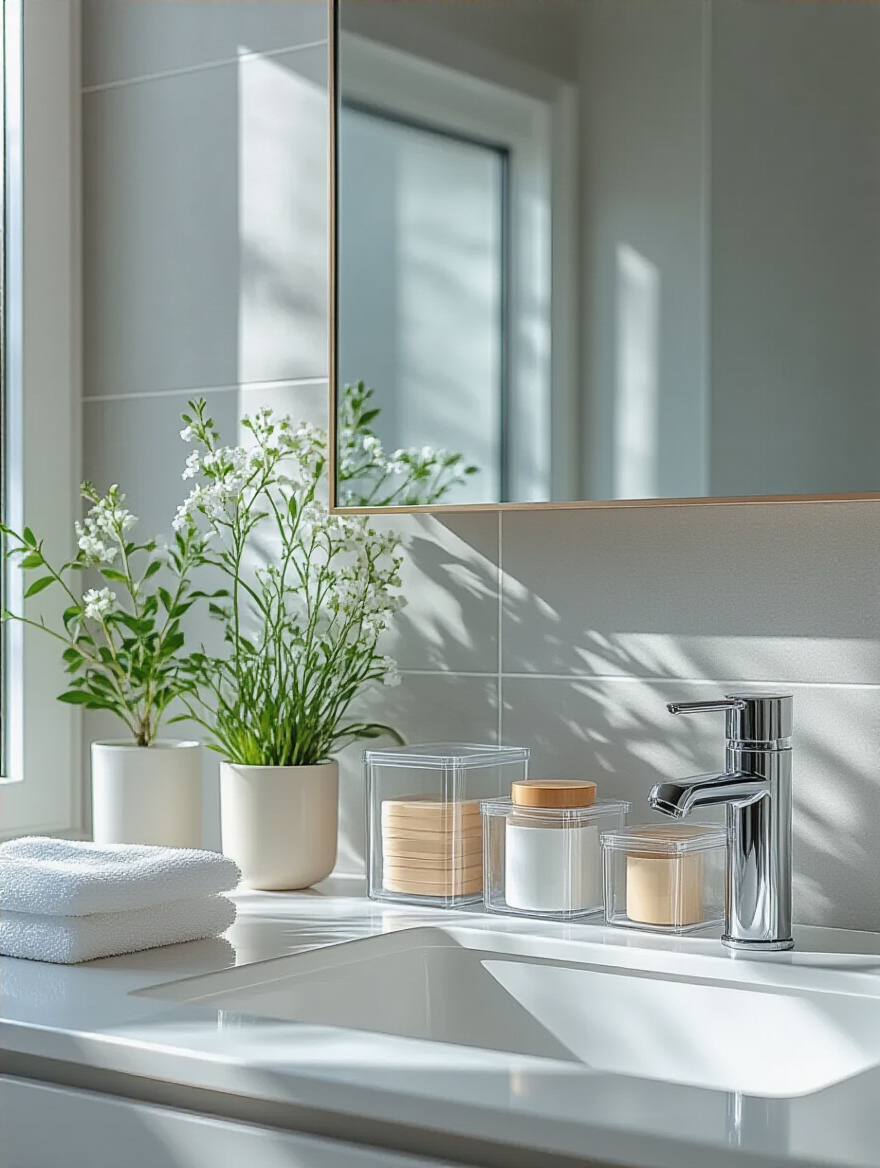
The process is simple, but not easy. Take everything out. Every last bottle, tube, and brush from every drawer and cabinet. Put it all on the floor. Now, pick up each item and make a decision: keep, toss, or relocate. For everything you keep, it needs a dedicated home that is not the countertop. Use drawer dividers, under-sink pull-out organizers, and medicine cabinet bins. The goal isn’t just to hide your stuff; it’s to create a system so efficient that your countertops stay clear automatically. A clear counter is the ultimate luxury signal.
With the clutter gone, your eye needs a place to land. That’s where the mirror comes in, and it does a lot more than just show your reflection.
3. Choose a Statement Mirror to Enhance Brightness
You know what people always ask me? “How do I make my small, dark bathroom feel bigger?” My first answer is always the same: upgrade your mirror. A mirror is an architectural tool masquerading as decor. It’s a light multiplier. From a photographer’s perspective, it’s like adding a second window. Placed opposite your main light source, it will literally double the amount of light bouncing around the room, erasing shadows and making the whole space feel more expansive.
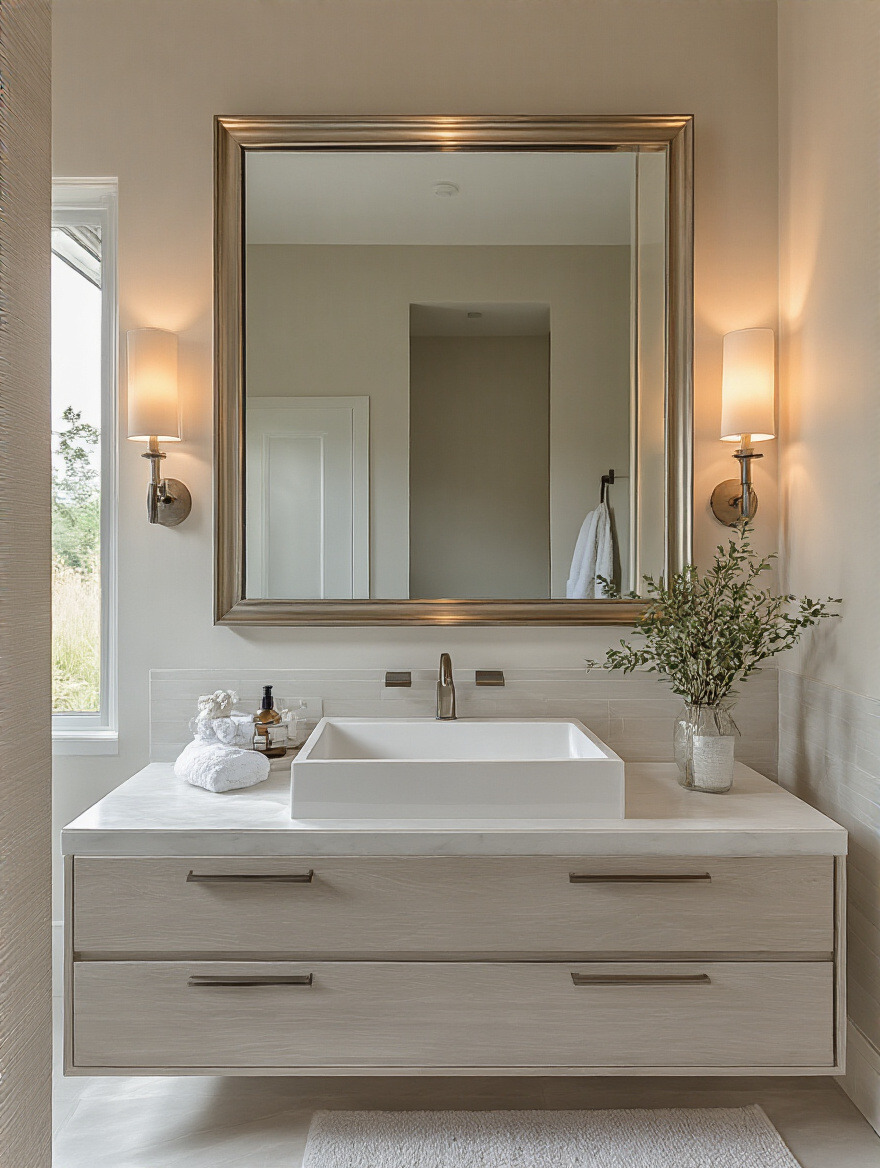
But don’t just grab any old rectangle. The size and shape matter. A common mistake is getting a mirror that’s too small for the vanity—it looks dinky and cheapens the whole look. A good rule of thumb is for the mirror to be slightly narrower than your vanity, or if you want to make a statement, go for a tall, oversized model that fills the vertical space. Whether it’s frameless for a minimal look, backlit with LEDs for a modern glow, or framed in a beautiful wood or metal to match your hardware, treat the mirror as the functional art piece that anchors the entire room.
Once you’ve manipulated the light and space, it’s time to add a layer of physical comfort that you can actually feel.
4. Select Premium Textiles for Elevated Comfort
I used to think towels were just towels. Then I stayed in a hotel that used proper, high-end Turkish cotton towels and it clicked. The difference is tactile. It’s sensory. Cheap, thin towels that feel like sandpaper after three washes just communicate neglect. Investing in premium textiles is one of the easiest ways to inject a daily dose of spa-like luxury into your life.
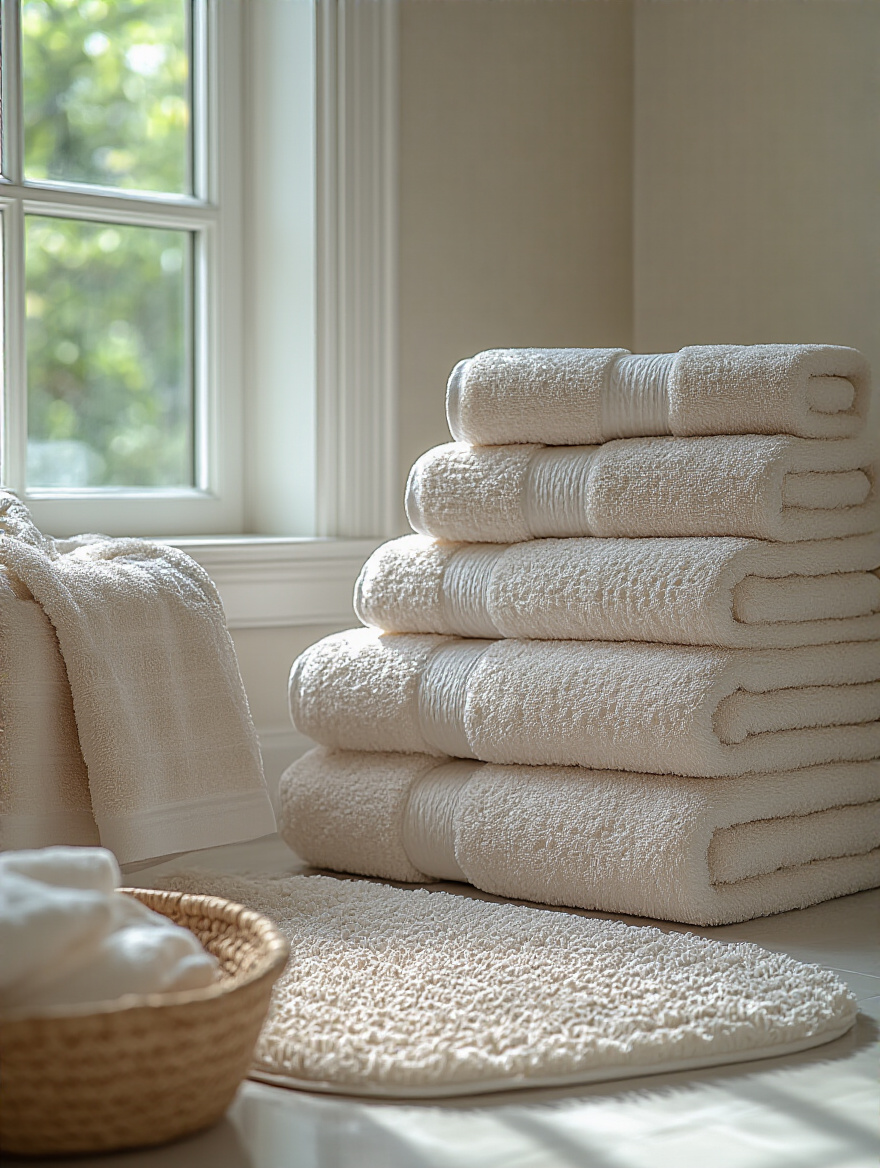
The key metric here is GSM, or Grams per Square Meter. Anything less than 500 is basically dish-towel territory. You want to be in the 600-900 GSM range for a plush, absorbent, five-star feel. Look for long-staple cotton like Egyptian or Turkish, which means the fibers are longer, stronger, and softer. And don’t forget the bath mat. Get something thick, absorbent, and non-slip. Stepping out of a shower onto a cloud is a feeling worth paying for. Coordinate the colors with your 60-30-10 palette, and suddenly the room feels cohesive and deeply comfortable.
With comfort locked down, let’s get back to the practical magic of making sure everything has a home.
5. Optimize Storage Solutions to Conquer Clutter
We talked about decluttering, but that’s only half the battle. Now you need a system. Bad storage is the root cause of chronic clutter. If items don’t have a logical, easy-to-access home, they will migrate to the countertop. It’s an iron law of domestic physics. Optimizing storage means thinking in three dimensions—it’s about using every cubic inch of your cabinets, drawers, and walls.
 Floating Shelves showcasing optimized storage solutions to reduce clutter” class=”wp-image-11275″/>
Floating Shelves showcasing optimized storage solutions to reduce clutter” class=”wp-image-11275″/>Don’t just buy a bunch of random plastic bins. Measure first. Get pull-out tiered shelves for under the sink to conquer that awkward, deep space. Use drawer dividers to compartmentalize makeup and toiletries. Go vertical with floating shelves or an over-the-toilet étagère for things you want to display, like folded towels or a nice plant. I once worked with a client who replaced their basic vanity with one that had deep, sectioned drawers. It looked the same from the outside, but inside it was a machine of organization. They said it saved them 10 minutes every single morning. That’s the power of good storage.
With the foundation set, your bathroom is now a well-organized, cohesive canvas. It’s time to layer on the elements that create true ambiance.
Enhancing Ambiance: Key Elements for Visual Impact
This is where we get into the stuff that makes a bathroom feel special. It’s about mood, texture, and personality. These are the details that elevate a functional space into a genuine retreat.
6. Layer Lighting for Versatile Function and Mood
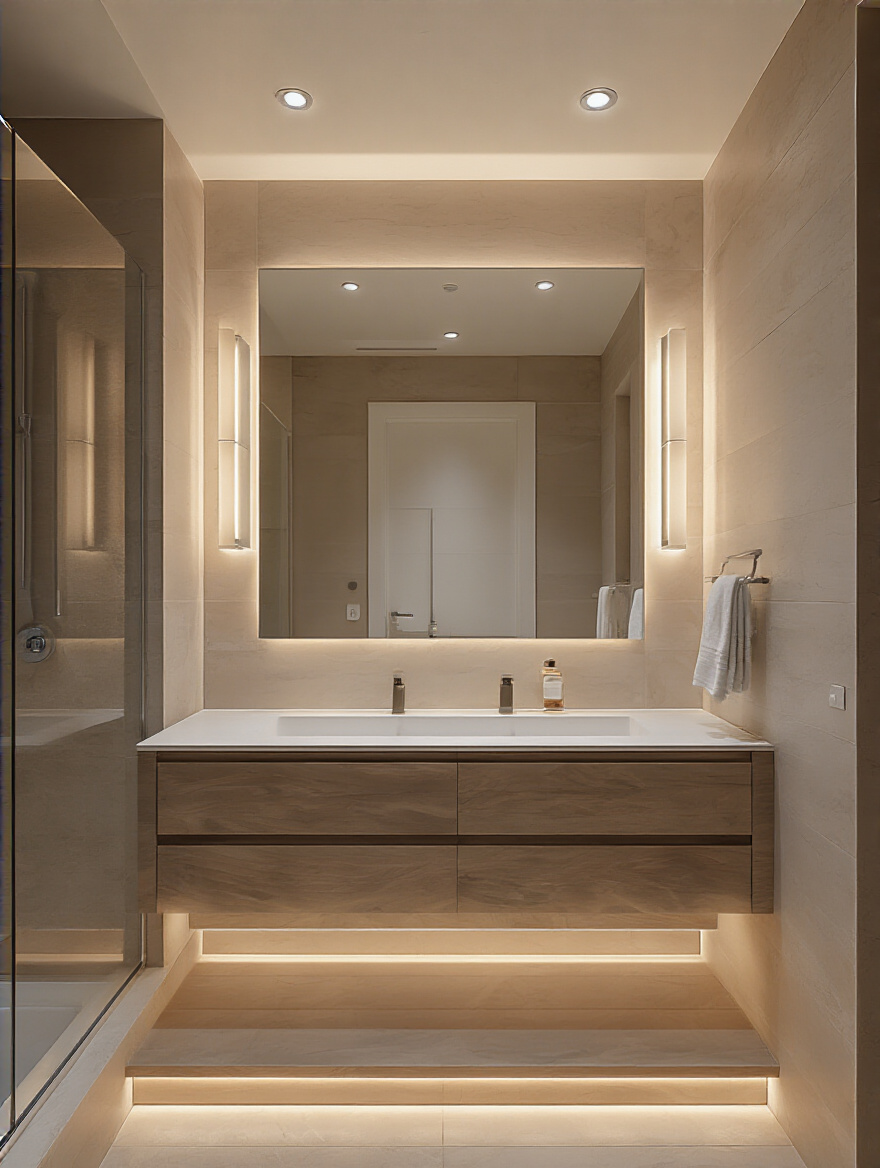
First is Ambient light: the general, overall illumination from recessed cans or a central fixture. Second, and most important, is Task light: this is for seeing your face. It should be flanking the mirror at eye level. Sconces on either side of the mirror will light your face evenly, eliminating those dark shadows under your eyes that an overhead light creates. Third is Accent light: a small, directional light for a piece of art, or an LED strip under a floating vanity for a soft glow. Put everything on a dimmer. This is non-negotiable. Full blast for getting ready in the morning, dimmed down to 20% for a relaxing bath at night. It’s the ultimate mood controller.
Now that you’re lit for success, it’s time to breathe some life into the space—literally.
7. Integrate Greenery to Infuse Natural Vibrancy
A bathroom can be a landscape of hard, cold surfaces: tile, porcelain, metal, glass. The fastest way to soften that landscape and make it feel alive is with plants. They add organic shape, texture, and a pop of vibrant color that nothing else can. But you can’t just throw any old fiddle-leaf fig in there and hope for the best. A bathroom is a specific microclimate: high humidity, often low light.
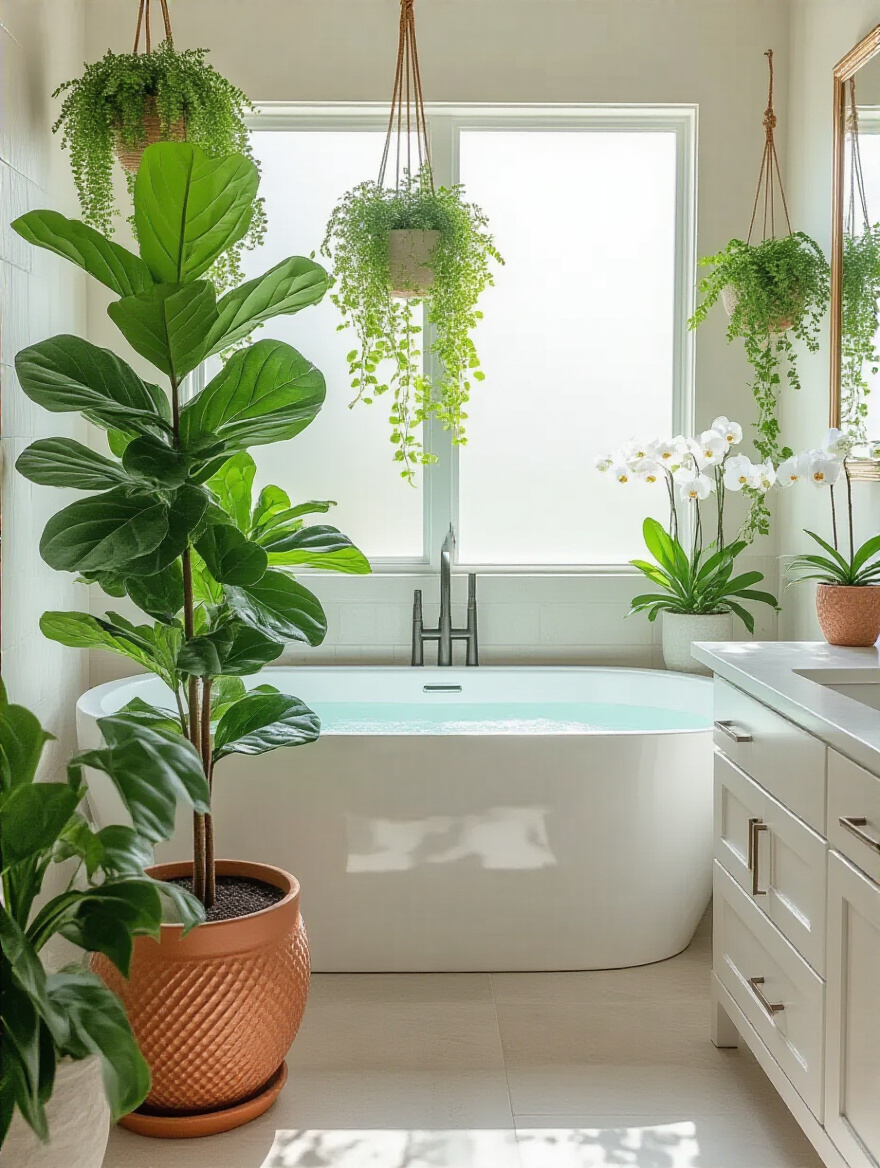
You need to choose plants that thrive in these conditions. Snake plants and ZZ plants are practically indestructible and tolerate low light. Pothos and philodendrons love humidity and look great trailing down from a high shelf or a hanging planter. Ferns, like the Boston or Bird’s Nest fern, are another fantastic choice for a steamy environment. The trick is to treat the planter as part of the decor—find a pot with a color or texture that ties into your overall palette. It’s a small detail that makes the greenery feel intentional, not like a random afterthought.
With living elements in place, it’s time to add a layer of personality with things that are uniquely you.
8. Curate Unique Wall Art and Decorative Elements
Empty walls in a bathroom feel sterile and impersonal. This is your chance to inject your personality into the space. But here’s the pet peeve: don’t just hang a cheap, mass-produced “Live, Laugh, Love” sign and call it a day. And please, for the love of all that is holy, don’t hang unprotected artwork that will be destroyed by the steam in six months.

You have to be smart about it. Look for prints you genuinely love and have them framed professionally with a good seal and acrylic glazing instead of glass, which is less prone to trapping moisture. Or, think beyond prints. A collection of small, sculptural ceramic objects on a floating shelf. A cluster of antique botanical illustrations. I once shot a powder room where the owner had hung a single, huge, dramatic abstract canvas over the toilet. It made the tiny room feel like an art gallery. It was unexpected, bold, and unforgettable.
Once your art is telling a story, let’s turn our attention to the smaller details that pull the whole look together.
9. Upgrade Hardware and Fixtures for a Polished Look
This is my favorite budget-friendly hack. If you do nothing else, updating your hardware and fixtures can have an outsized impact on your bathroom’s look. I’m talking about cabinet knobs and pulls, towel bars, the faucet, and the showerhead. Think of these as the jewelry of the room. Dated, tarnished brass or builder-grade chrome can drag down the entire aesthetic.
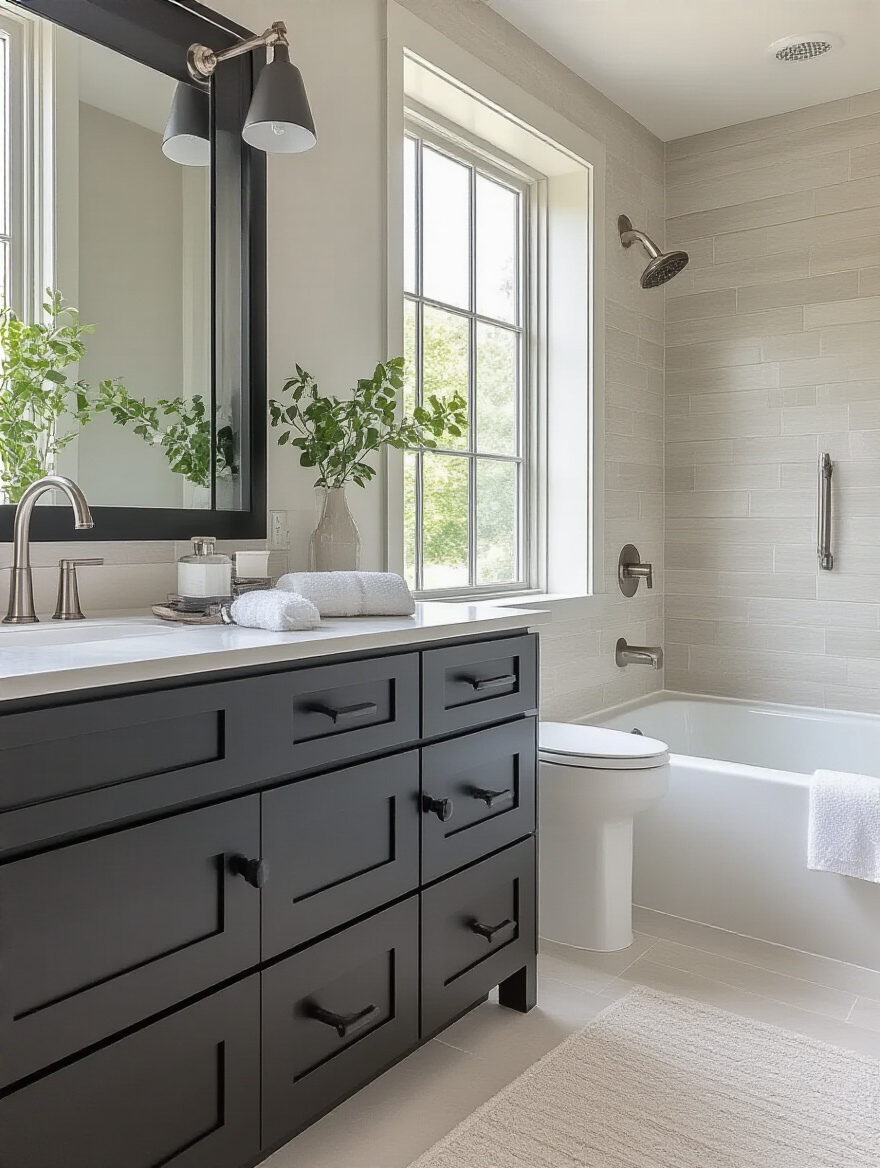
Changing them out for a modern finish like matte black, brushed gold, or satin nickel is a weekend project that makes the room look 10 years younger. The key is consistency. Make sure all your metals match or are intentionally complementary. And while you’re at it, upgrade to a faucet that feels substantial and a showerhead that gives you great water pressure. It’s a small change that improves both the look of the room and your daily experience in it. It signals quality and attention to detail.
Next, we tackle the largest single piece of “fabric” in the room: the shower curtain.
10. Choose an Impactful Shower Curtain or Door Design
A shower curtain is a 72×72-inch wall of fabric. It’s a massive visual element, yet most people treat it as an afterthought, grabbing a cheap plastic liner and a boring beige curtain. This is a huge missed opportunity. You can use it to introduce a bold pattern, a rich texture, or a dramatic color that ties your whole palette together. Or, if your goal is to make the room feel bigger, a clear glass door is the ultimate solution.
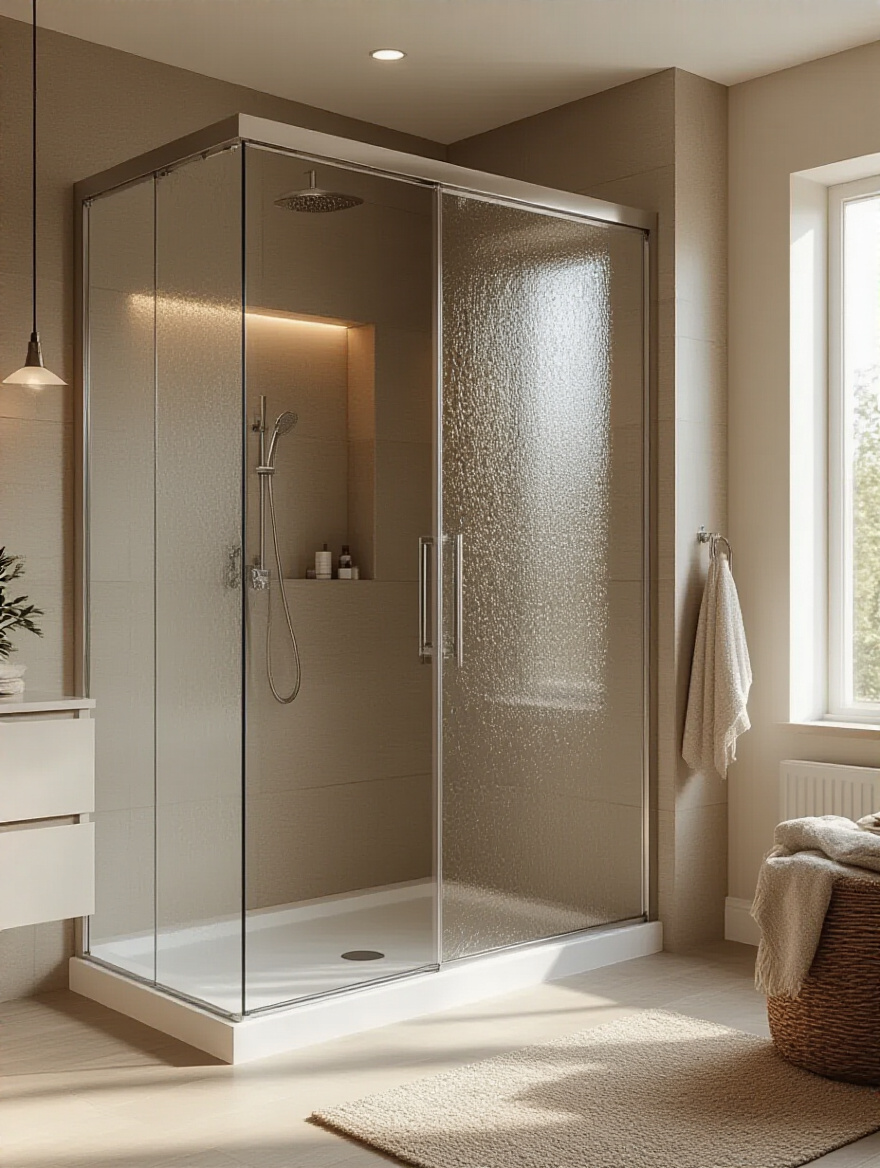
But if you’re going with a fabric curtain, here’s the pro trick you need to know: buy an extra-long and extra-wide curtain. Hang the rod as close to the ceiling as possible and use a curtain that’s wide enough to have some elegant, flowing drape instead of being stretched taut. This is a classic interior design trick that draws the eye upward, making the ceiling feel higher and the entire space feel more luxurious and custom, like drapery in a high-end living room. It’s the difference between a cheap motel and a boutique hotel.
Now that we’ve addressed the visual senses, it’s time to engage the most powerful one for setting a mood: smell.
11. Infuse Aromatherapy for a Spa-Like Sensory Experience
Scent is a shortcut to emotion. It’s why real estate agents bake cookies before an open house. In a bathroom, aromatherapy can instantly transform the vibe from purely functional to a relaxing, spa-like sanctuary. The trick is to do it with subtlety and quality, otherwise, it can quickly feel cheap and overwhelming.
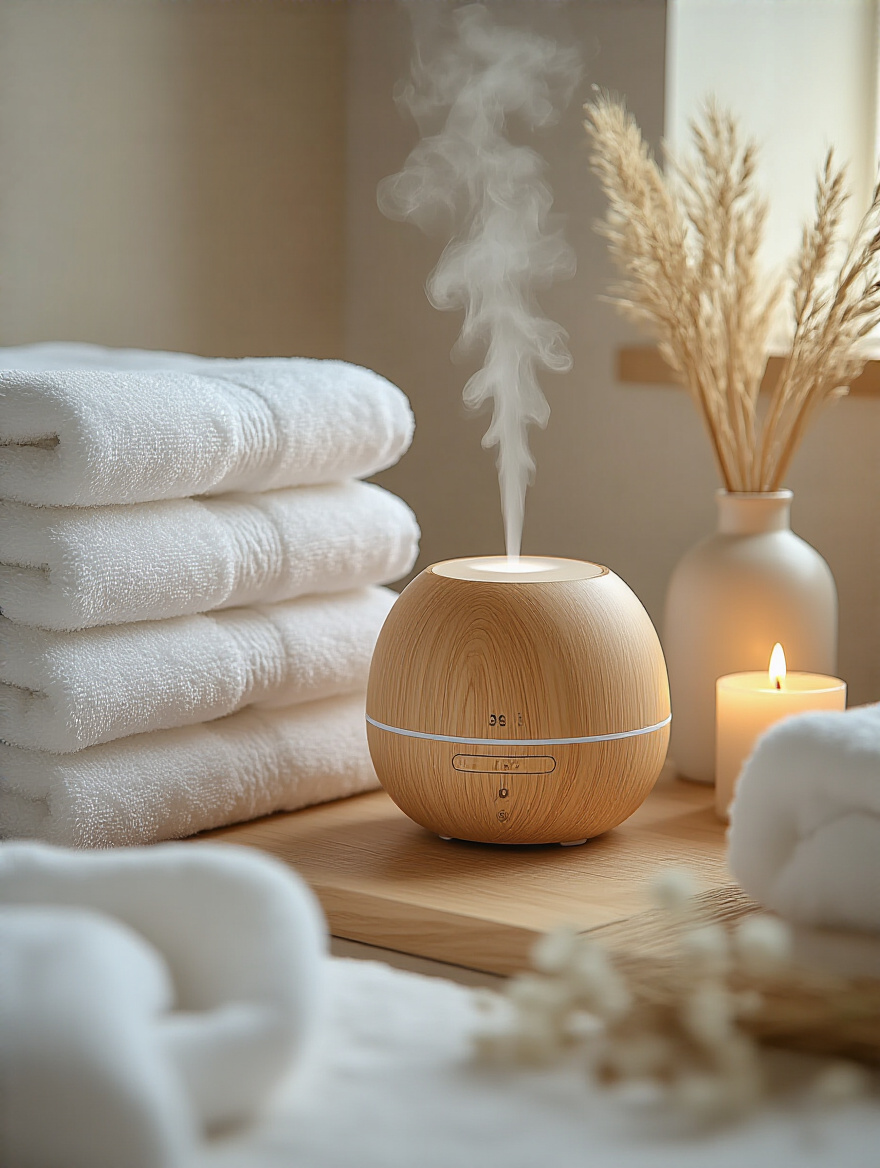
Forget those chemical-laden plug-in air fresheners. The best tools are an ultrasonic diffuser, which creates a fine, cool mist of water and essential oils, or a simple reed diffuser. Choose high-quality, 100% pure essential oils. For a calming, spa-like scent, go with lavender, chamomile, or eucalyptus. For a more invigorating morning vibe, try citrus oils like grapefruit or bergamot. A client of mine started putting a few drops of eucalyptus oil on the shower floor before turning on the hot water. The steam activates the oil, turning her entire bathroom into a personal steam room. It’s a simple, two-second ritual that completely changes her morning.
Maximizing Functionality: Smart Solutions & Daily Living
A beautiful bathroom that doesn’t work well is just a pretty frustration. This section is about the clever moves and practical solutions that make your daily routines smoother, easier, and more efficient.
12. Optimize Vanity Counter Organization for Daily Ease
We talked about getting things off the counter, but let’s drill down on the ‘how.’ The goal is to create a functional, serene workspace. Your vanity should be organized like a chef’s kitchen, with everything you need within arm’s reach but neatly contained. Think in terms of “zones.”
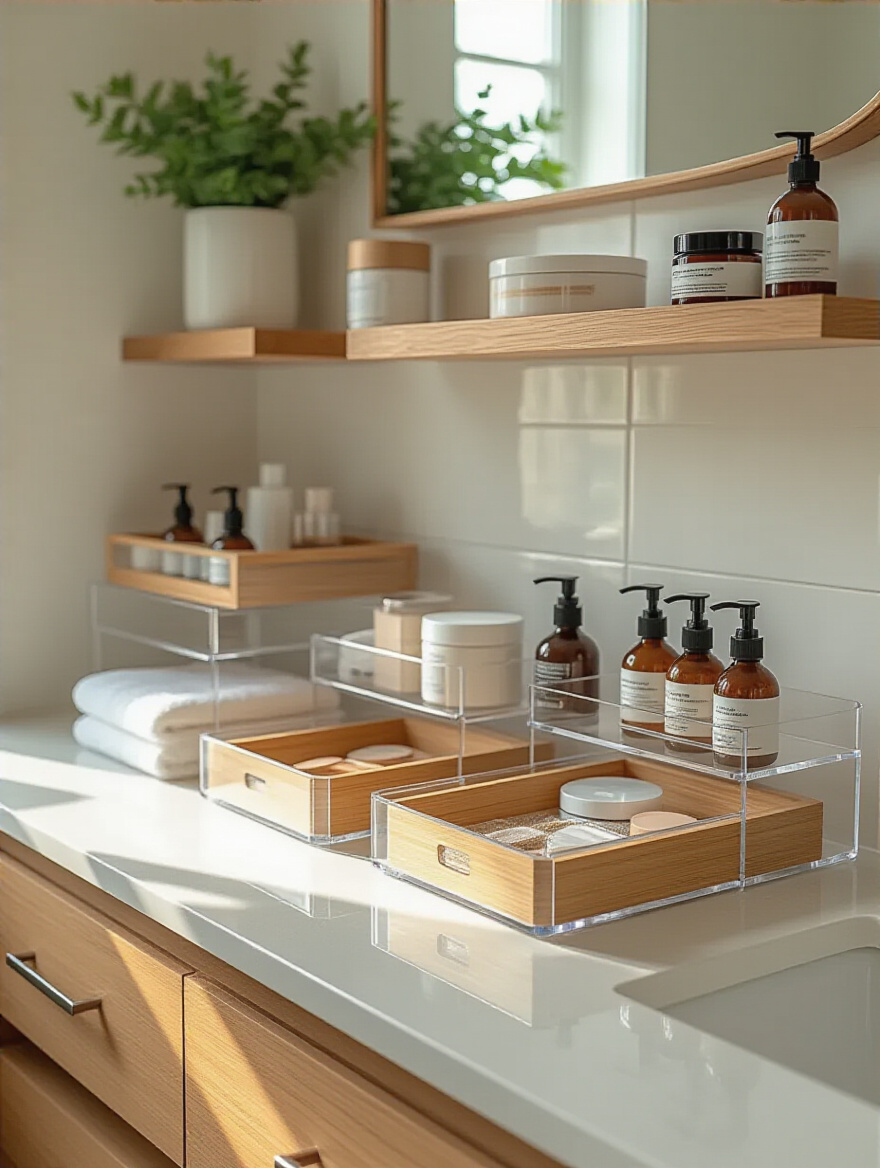
Use clear acrylic trays to corral your daily skincare products into one zone. Use a nice cup or holder for toothbrushes and toothpaste in another. Makeup can go in a multi-compartment organizer. By grouping like items, you create visual order out of chaos. A tiered stand can be a game-changer, using vertical space for smaller items. This isn’t about hiding things away in drawers, but about curating what stays out so that it looks intentional and stylish, not messy.
Once the horizontal surface of your vanity is under control, look up. It’s time to leverage your walls.
13. Utilize Strategic Open Shelving for Stylish Displays
Open shelving is fantastic, but it walks a fine line between a chic, curated display and just looking like exposed clutter. The key is balance and restraint. You can’t just dump all your stuff on a shelf. Open shelves are for a mix of functional and beautiful items.
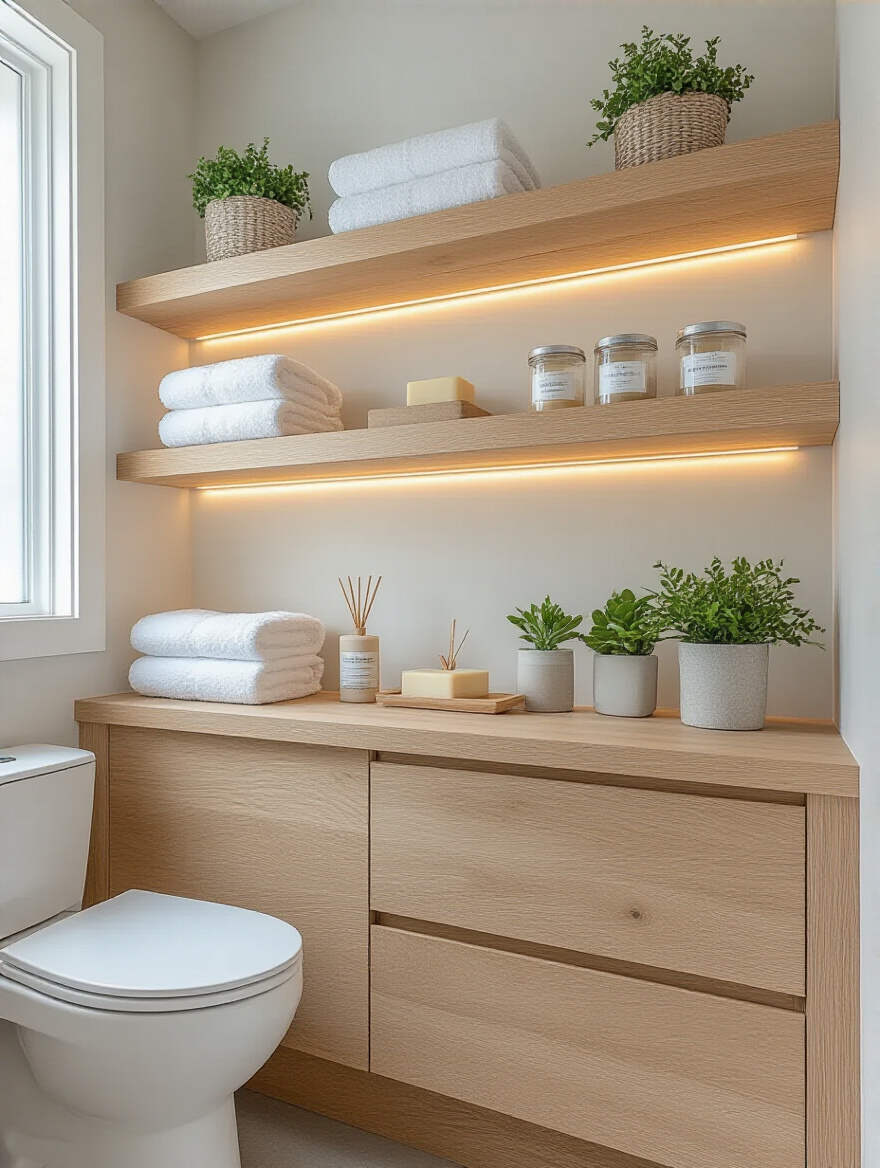
Here’s a good formula: 1/3 practical items (like neatly rolled or folded towels), 1/3 decorative items (a plant, a candle, a small sculpture), and 1/3 empty space. That negative space is crucial; it gives the items room to breathe and keeps the display from feeling heavy and cluttered. Use them in smart locations, like over the toilet or in a narrow niche next to the vanity. And make sure the shelves themselves are stylish—a thick piece of reclaimed wood on metal brackets or sleek glass shelves can be a design statement in their own right.
From the walls, our eyes travel down. Let’s make sure the ground beneath our feet is just as well-considered.
14. Refresh Flooring for Durable Style and Safety
Flooring is one of the most foundational elements in a bathroom. It sets the tone for the entire space and, more importantly, it’s a critical safety feature. A slippery floor in a wet environment is a disaster waiting to happen. If you’re renovating, this is not the place to skimp.
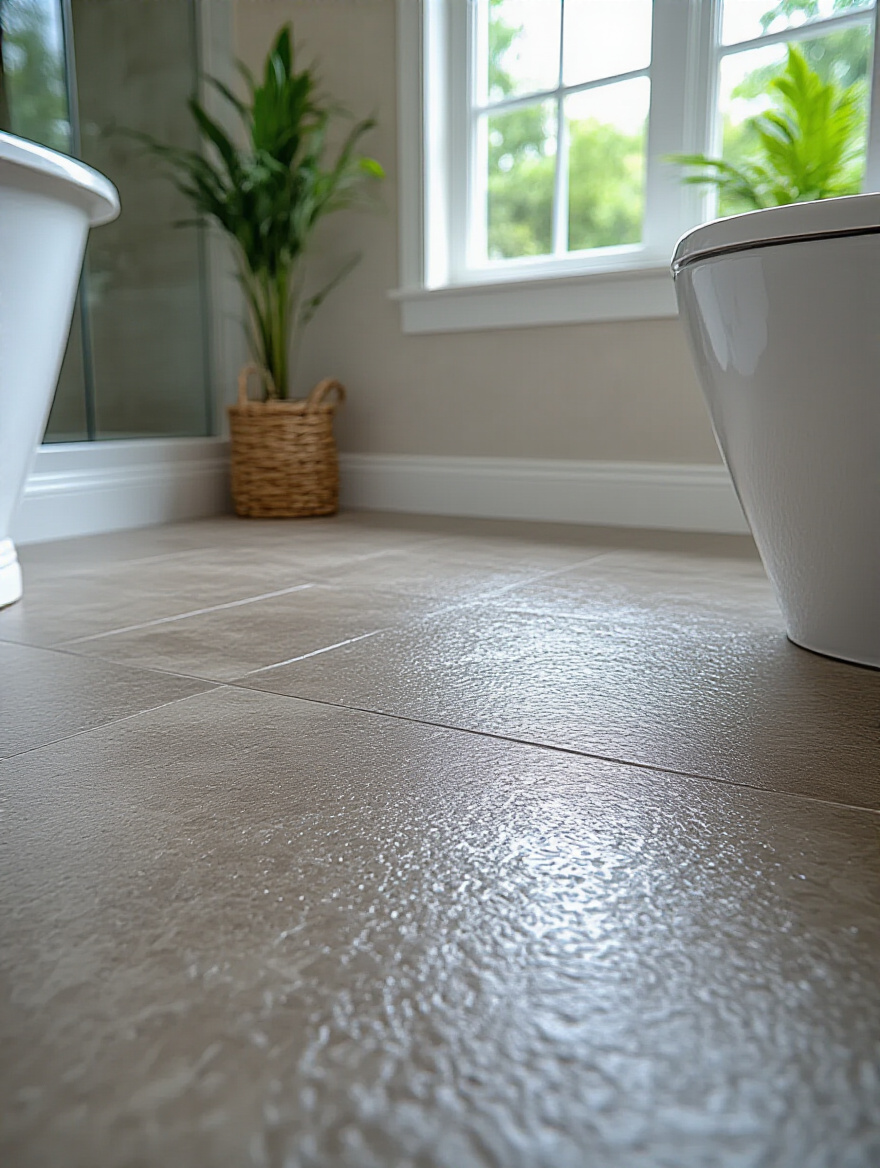
When choosing a material, your first priority should be its DCOF rating (Dynamic Coefficient of Friction), which measures slip resistance. For a residential bathroom, you want a rating of 0.42 or higher. Textured porcelain tile is an excellent, durable, and safe choice. From a design perspective, think about scale. I love using large-format tiles (like 24×24 or even 12×24 inches) in a small bathroom. It sounds counterintuitive, but fewer grout lines trick the eye into seeing a larger, more seamless space. It’s a powerful visual illusion.
Now let’s bring that same transformative power back up to the walls with one of the most high-impact updates you can make.
15. Apply Smart Paint or Wallpaper Accents for Transformation
Want to completely change the mood of your bathroom in a weekend for under $200? Paint or wallpaper an accent wall. It’s the highest ROI project in the design world. It creates an instant focal point, adds depth, and injects a massive dose of personality. The wall behind your vanity and mirror is the perfect candidate.
The critical thing here is to use the right materials. For paint, you need a formulation designed for kitchens and baths that has mildew-resistant additives, and go with a satin or semi-gloss finish for better moisture repellency and cleanability. If you’re using wallpaper, you absolutely must use vinyl or a product specifically rated for high-humidity environments. I once saw a client use gorgeous, expensive grasscloth wallpaper in a bathroom. A year later, it was a peeling, moldy mess. Don’t make that mistake. Choose your material for the environment it’s going into.
If a full accent wall feels like too much, you can get a similar impact with smaller, more manageable projects.
16. Execute Budget-Friendly DIY Decor Projects with Impact
You don’t need a huge budget to make a huge impact. Some of the most satisfying transformations come from clever, hands-on DIY projects. The secret is to focus on projects that deliver the most visual bang for your buck.
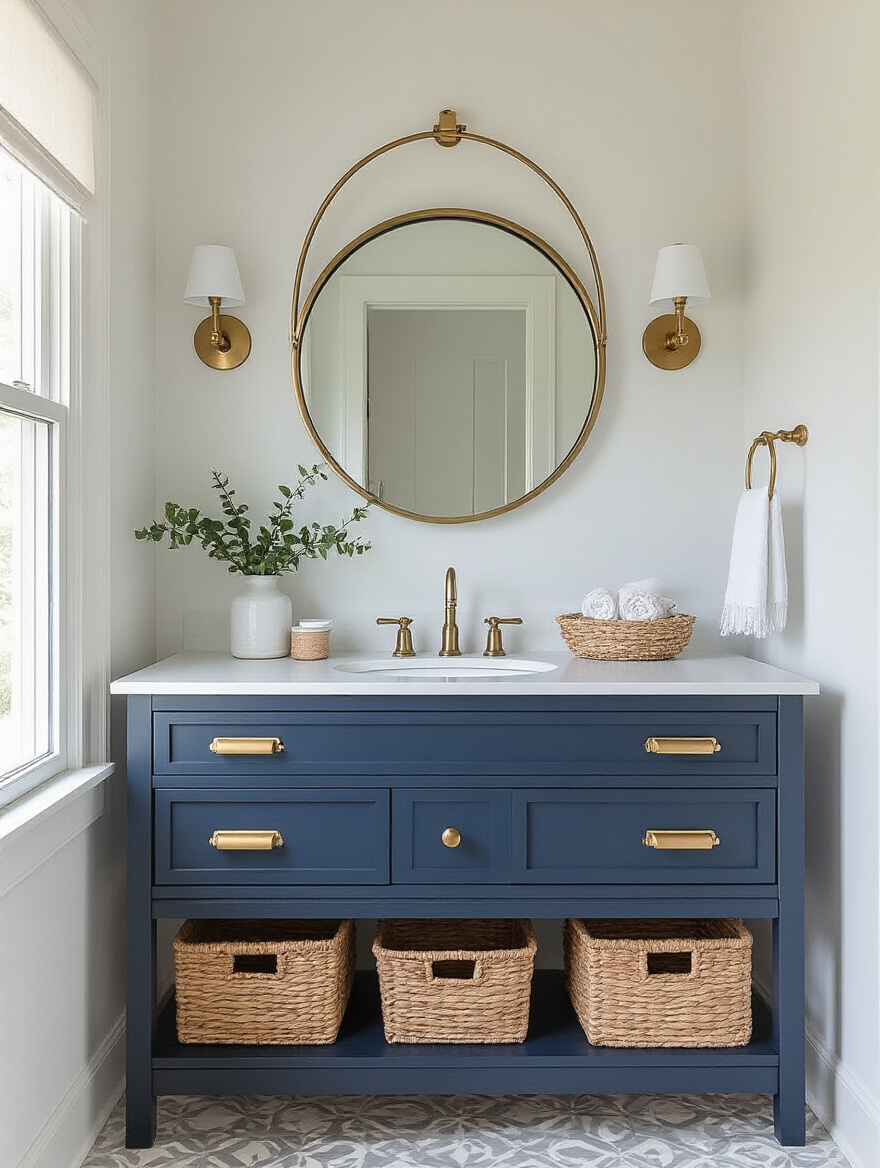
Number one on the list: paint your old, dated vanity. With proper prep—and I mean meticulous cleaning, sanding, and a high-quality bonding primer—you can make an old oak or melamine cabinet look like a custom, high-end piece for less than $100. Another great one is framing a basic, plate-glass mirror. You can buy kits or simply mitre-cut molding, paint it to match your hardware, and glue it directly onto the mirror for an instant custom look. These small projects elevate the space and give you the satisfaction of having done it yourself.
With these fundamentals mastered, let’s push the envelope with a few advanced ideas that can make your space truly one-of-a-kind.
Advanced Concepts: Mastering Unique Spaces & Modern Upgrades
This is for when you want to move beyond just a “nice” bathroom and create something truly special. These are the touches that blend deep personalization with cutting-edge convenience for a space that is both a reflection of you and a step into the future.
17. Integrate Personalized Keepsakes and Meaningful Art
This goes a step beyond just hanging nice art. This is about making the bathroom a part of your home’s story. It could be framing a collection of postcards from your travels, a shadow box with your grandfather’s old shaving kit, or a small, beautiful bowl you picked up on vacation that now holds bath salts. These objects have a resonance that a store-bought accessory just can’t match.
The key is curation and presentation. Group smaller items together to give them more presence—a “micro-gallery” on a small shelf. Ensure everything is protected from moisture as we discussed earlier. When I shoot a home, it’s these Personal Touches that make the photos feel warm and authentic. They tell me who lives there. Your bathroom, the most private room in your house, is the perfect place for these quiet, meaningful narratives.
From the deeply personal, we now turn to the deeply practical problem that plagues so many bathrooms.
18. Cleverly Design for Maximum Small Bathroom Spaciousness
I’ve photographed countless tiny urban bathrooms, and the successful ones all follow the same principles. The goal is to get as much stuff off the floor as possible to create an uninterrupted sightline. This is the secret to making a small space feel big. Every square inch of visible floor is visual gold.
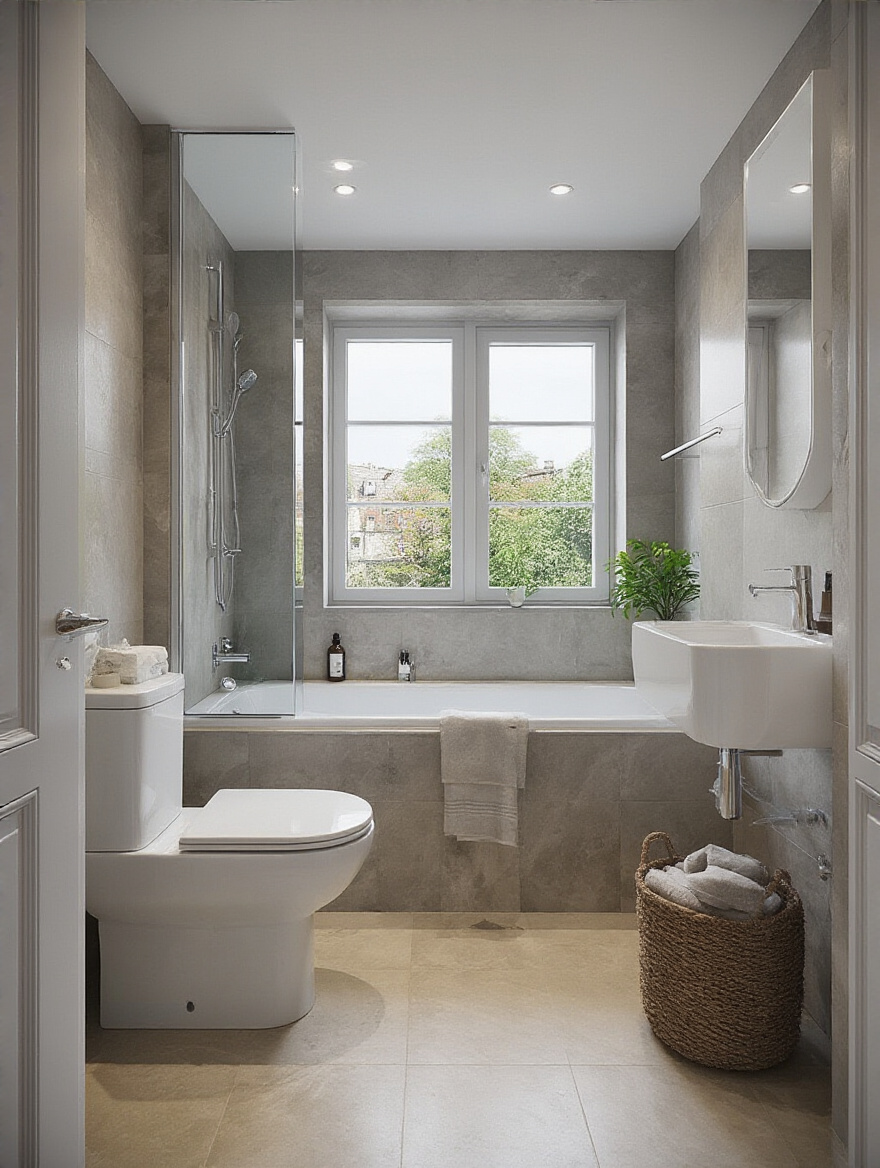
Your toolkit includes: a wall-mounted or “floating” vanity, which exposes the floor underneath. A wall-hung toilet, which does the same. A frameless glass shower panel instead of a curtained enclosure; its transparency makes the room feel like one continuous space. And, as mentioned, large-format tiles with matching grout to create a seamless visual field. These aren’t just style choices; they are strategic architectural maneuvers designed to fight claustrophobia and create a sense of airy calm in a tight footprint.
Finally, let’s look at the upgrades that bring your bathroom into the 21st century with unparalleled convenience and a touch of a ‘wow’ factor.
19. Incorporate Smart Tech for Modern Convenience and Luxury
Smart home technology is no longer just for the living room. It’s making the bathroom more efficient, hygienic, and luxurious. I’m not talking about gimmicks, but about tech that solves real problems. Start with what’s actually useful. A smart mirror with built-in, tunable LED lighting and an anti-fog heating pad is a game-changer on rushed mornings. A smart bidet toilet seat is a hygienic upgrade that, once you try it, you’ll wonder how you lived without it.
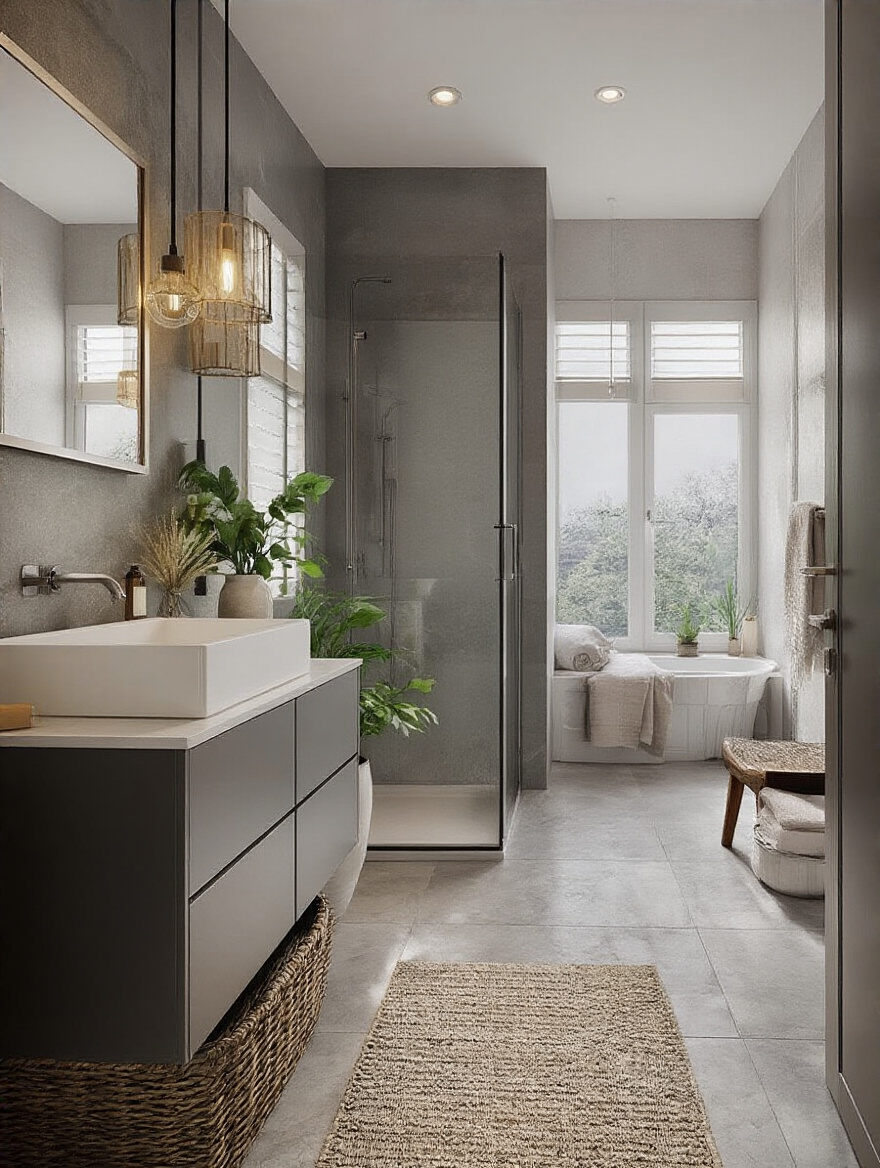
For the ultimate luxury, there are programmable digital showers that let you set the precise temperature and flow for different users, and can even integrate steam functions. And voice control is becoming standard, letting you adjust lights, play music, or get the morning headlines without touching a thing. The trick is to ensure you have a robust Wi-Fi signal in the bathroom and to choose products that integrate with a single smart home system (like Google Home or Apple HomeKit) for seamless control. It’s about building a bathroom that actively works for you.
Conclusion
Don’t get overwhelmed. You don’t have to do it all at once. Pick one thing from this list. Upgrade your hardware. Buy some incredible new towels. Paint an accent wall. Every intentional choice you make moves you closer to a bathroom you truly love. And when that space supports and restores you at the start and end of each day, that’s an investment that pays you back in ways you can’t even measure.
